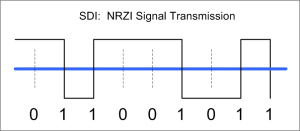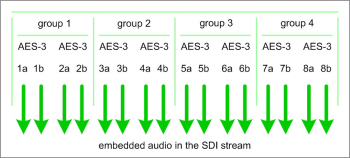

SDI signals are transmitted as unbalanced signals on 75 Ohms coax cable and 75 Ohms BNC connectors. Transmission and reception involves differential amplifiers that format and detect both data phases. The signal amplitude at the source is 800 mV (±10%) peak-to-peak. Transmitted are digital component signals (YCbCr), 10bit.
The first standardized digital component signal was defined in 1987 with the creation of the D1 format and the standard SMPTE 125M. It was an 8/10 bit parallel system used for connections between digital tape recorders. D1 was distributed over 8 to 10 twisted pairs and the interface was a 25-pin D-sub miniature connector.
Distributing digital video as a single bit-stream on a coax cable has significant advantages, even with much higher bit rates. It's much easier to route and switch one cable than a parallel system of cables and there will be no issues with clock and data synchronization between different signal paths.
The SDI format utilizes a differential signaling technique and NRZI (non-return to zero inverted) coding. Differential reception creates additional headroom and robustness in signal-to-noise performance. Pseudo-randomizing the data bits and use of NRZI coding increases channel transmission reliability and NRZI coding is desirable because its operation is independent of signal polarity.
High and low levels do not communicate as data 1s or 0s. High and low states are detected simply by the change from one level to another (a zero means that the transmission level stays the same, while a one is transmitted if the level transition from one level to the other occurs.
 |
| SD-SDI data structure |
 |
| HD-SDI data structure |
The SDI signal is transmitted by using the NRZI method ("non return to zero, inverted"). The binary signal is mapped to a physical signal for transmission. The logical "1" is represented by a transition of the physical level, the logical "0" is represented by NO transition. The signal level has a nominal value of 800mV.

Standards are defined by the Society of Motion Picture and Television Engineers (SMPTE) for serial digital video transmissions (SDI), the standards define the coding and decoding of the SDI single bit-stream.
ITU-R BT.601| Aspect Ratio | Scanning Type | Number of Pixels V | Number of Pixels H | Number of Pixels V | Total Number of Pixels per Frame to be displayed |
| 480i | 4:3 | interlaced | 480 | 640 | 307,200 |
| 480p | 4:3 | progressive | 480 | 640 | 307,200 |
| 480p | 16:9 | progressive | 483 | 720 | 347,760 |
| 720p | 16:9 | progressive | 720 | 1280 | 921,600 |
| 1080i | 16:9 | interlaced | 1080 | 1920 | 2,073,600 |
| 1080p | 16:9 | progressive | 1080 | 1920 | 2,073,600 |
Embedded Audio: Standard SMPTE 299M
AES digital audio signals, 24bit, can be inserted into the 1.485 Gb/s SMPTE 292M bitstream. 16 channels, SMPTE 299M allocates four groups of four audio channels that can be embedded. One group consists of two AES channels (each two audio channels L+R).

SMPTE 259M (SD Video) is also defined with four groups of four audio channels, but these are not defined as perfectly phase coherent and should not be used for surround sound transmission.
With SMPTE 292M (HD Video) and SMPTE 299M phase coherence between the audio channel groups is higher.